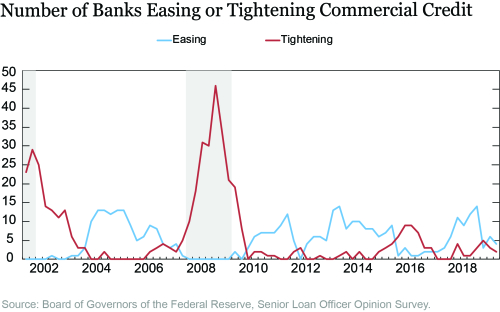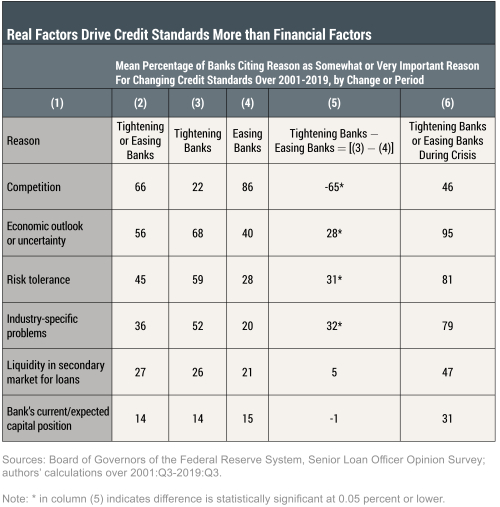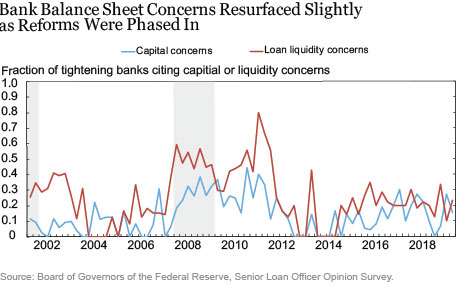Did the 2007-09 financial crisis or the regulatory reforms that followed alter how banks change their underwriting standards over the course of the business cycle? We provide some simple, “narrative” evidence on that question by studying the reasons banks cite when they report a change in commercial credit standards in the Federal Reserve’s Senior Loan Officer Opinion Survey. We find that the economic outlook, risk tolerance, and other real factors generally drive standards more than financial factors such as bank capital and loan market liquidity. Those financial factors have mattered more since the crisis, however, and their importance increased further as post-crisis reforms were phased in in the middle of the following decade.
Measuring Credit Standards
The Fed’s Senior Loan Officer Opinion Survey (SLOOS) is a quarterly survey of about eighty large domestic banks and twenty-four foreign banks. The domestic banks, our focus, account for roughly 70 percent of all U.S. banks’ assets. The first question in the survey asks about credit standards for commercial and industrial (C&I) loans:
Over the past three months, how have your bank’s credit standards for approving applications for C&I loans or credit lines—other than those to be used to finance mergers and acquisitions—to large and middle-market firms changed?
a. Tightened considerably
b. Tightened somewhat
c. Remained basically unchanged
d. Eased considerably
e. Eased somewhat
The chart below plots the number of banks reporting tightening and easing between 2001 and 2019. Banks tend to cycle from easing to tightening before recessions but that shift had never been so dramatic as during the 2007-09 crisis. Researchers have found that tighter standards strongly predict slowdowns in bank credit growth and economic activity (Lown and Morgan; Basset et al.).

What Drives Credit Standards?
Banks reporting a change in credit standards or terms are asked to rate the importance of various factors in driving the change. The set of reasons offered since at least 2001 is listed in the table below in slightly abridged form (the full text is here). Easing and tightening banks are offered the same set of reasons, except with the directions reversed. For example, the text on bank capital is either “improvement in your bank’s current or expected capital position” or “deterioration …”
The second column below reports the mean share of respondents that ranked the reason as either very or somewhat important. By that (simple) metric, real factors drive standards more than financial factors like bank capital and liquidity. That is notable in light of recent academic literature stressing the importance of banks’ capital strength in driving credit supply (Bernanke and Gertler; Peek and Rosengren). Of course, the hypothesis of a bank capital channel is that capital also matters, along with real factors, not that it matters more. Note also that financial factors were markedly more important during the financial crisis, as shown in the final column.

Columns (3) and (4) report the means separately for banks that reported easing or tightening and column (5) reports the difference in means. The financial factors matter symmetrically, that is, increased concerns about banks’ capital or loan liquidity drive easing standards as much (or as little) as decreased concerns drive lower standards. The real factors, by contrast, matter asymmetrically, with all but one mattering more for tightening than for easing. The exception is competition; increased competition among lenders drives standards downward much more than weaker competition drives them upward. The strong link between increased competition and easing standards is consistent with the long-standing notion that increased competition spurs more risk taking by banks (Carlson, Correia and Luck provide interesting historical evidence on that conjecture; Goetz reviews the literature). However, we’re not aware of theories that predict the asymmetric effects of competition on credit standards.
Different Drivers Since the Crisis?
To see if the drivers have changed since the financial crisis of 2008-09, we compare the average share of banks reporting that a reason was important before the crisis to the average share after the crisis, conditional on the number of banks that changed standards. Technically, we regressed the number of banks saying x was an important reason why they tightened or eased each quarter on a constant, a “post-crisis” indicator, and the number of banks that tightened or eased. Given the asymmetries just noted, we estimated separate models for easing and tightenings. The chart below summarizes the results. The asterisks over the red bars indicate if that reason was significantly more or less important after the crisis.
While real factors still predominate over the cycle, financial factors are more significant since the crisis. On the easing side, the mean share of easing banks citing their capital position rose from 18 percent to 23 percent, eclipsing banks’ own risk tolerance in importance. On the tightening side, both capital and loan market liquidity were more significant drivers; the mean share of tightening banks citing capital concerns increased from 5 percent to 14 percent while the mean share citing liquidity concerns increased from 7 to 18 percent.

To see what’s behind the post-crisis shift, we plot the fraction of tightening banks citing capital and liquidity concerns below. Those concerns remain elevated for several years after the crisis, which partly explains their heightened importance since the crisis. That post-crisis “hangover” is not the whole story, however, since capital and liquidity concerns resurged somewhat in the middle of the decade.

That resurgence roughly coincides with the finalization of stricter bank capital and liquidity rules in 2013 and 2014, respectively, and their gradual implementation over the next few years. We can’t put too fine a point on this interpretation given our simple analysis, but the timing squares with other recent evidence that those reforms might have unintentionally reduced or reallocated bank credit supply (for example, Roberts, Sarkar, and Shachar; Kovner and Van Tassel). Of course, the policy question is whether any such costs of reforms outweigh the benefits of increased bank resilience and financial stability, a more difficult question indeed.

Sarah Ngo Hamerling is a senior research analyst in the Federal Reserve Bank of New York’s Research and Statistics Group.

Donald P. Morgan is an assistant vice president in the Bank’s Research and Statistics Group.
 John Sporn is a collateral value analysis associate in the Bank’s Markets Group.
John Sporn is a collateral value analysis associate in the Bank’s Markets Group.
How to cite this post:
Sarah Ngo Hamerling, Donald P. Morgan, and John Sporn, “Bank Capital, Loan Liquidity, and Credit Standards since the Global Financial Crisis,” Federal Reserve Bank of New York Liberty Street Economics, October 21, 2020, https://libertystreeteconomics.newyorkfed.org/2020/10/bank-capital-loan-liquidity-and-credit-standards-since-the-global-financial-crisis.html.
Disclaimer
The views expressed in this post are those of the authors and do not necessarily reflect the position of the Federal Reserve Bank of New York or the Federal Reserve System. Any errors or omissions are the responsibility of the authors.











 RSS Feed
RSS Feed Follow Liberty Street Economics
Follow Liberty Street Economics